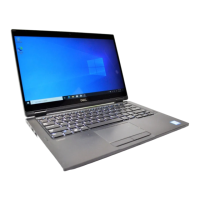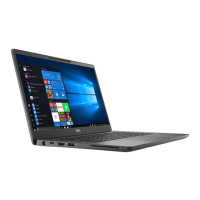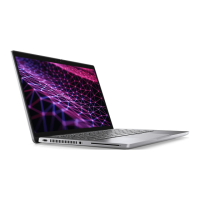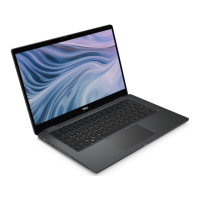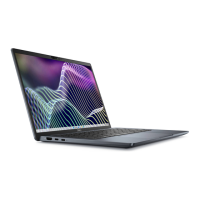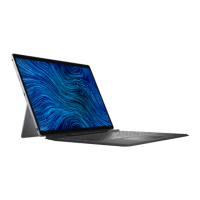Do you have a question about the Dell Latitude 7389 and is the answer not in the manual?
Guidelines to protect your computer from potential damage and ensure personal safety.
Procedure to shut down the operating system and turn off the computer.
Steps to prepare the workspace and computer before internal maintenance.
Steps to reconnect devices and cables after internal maintenance.
Procedures for removing and installing the computer's system board.
Details the types and specifications of the computer's processors.
Details the specifications for different battery types, including capacity, voltage, and lifespan.
Configuring AC behavior, auto-on times, and USB/WLAN wake settings.
Step-by-step guide to update the system BIOS from within Windows.
Creating, assigning, and managing system and setup passwords for security.
Performing hardware checks using the embedded ePSA diagnostics.
Step-by-step guide to initiate and run ePSA diagnostic tests.
| Internal memory | 16 GB |
|---|---|
| Memory form factor | On-board |
| Internal memory type | LPDDR3-SDRAM |
| SSD capacity | The Solid State Drive's storage capacity in Gigabytes. |
| Storage media | SSD |
| Optical drive type | No |
| Card reader integrated | Yes |
| Total storage capacity | 256 GB |
| Compatible memory cards | SD |
| Number of SSDs installed | 1 |
| Form factor | Convertible (Folder) |
| Product type | Hybrid (2-in-1) |
| Product color | Black |
| Pixel pitch | 0.144 x 0.144 mm |
| Display surface | Matt |
| Display diagonal | 13.3 \ |
| Touch technology | Multi-touch |
| Touchscreen type | Capacitive |
| Display brightness | 255 cd/m² |
| Native aspect ratio | 16:9 |
| On-board graphics card ID | 0x5916 |
| Discrete graphics card model | Not available |
| On-board graphics card model | Intel® HD Graphics 620 |
| Maximum on-board graphics card memory | 32 GB |
| On-board graphics card OpenGL version | 4.4 |
| On-board graphics card base frequency | 300 MHz |
| On-board graphics card DirectX version | 12.0 |
| On-board graphics card dynamic frequency (max) | 1150 MHz |
| Audio system | MaxxAudio Pro |
| Speaker power | 2 W |
| Speakers manufacturer | Waves |
| Number of built-in speakers | 2 |
| Video capturing speed | 30 fps |
| Front camera resolution | 1280 x 720 pixels |
| Wi-Fi standards | 802.11a, Wi-Fi 5 (802.11ac), 802.11b, 802.11g, Wi-Fi 4 (802.11n) |
| Top Wi-Fi standard | Wi-Fi 5 (802.11ac) |
| HDMI version | 1.4 |
| Charging port type | DC-in jack |
| USB 2.0 ports quantity | 0 |
| Pointing device | Touchpad |
| Operating system architecture | 64-bit |
| AC adapter frequency | 50 - 60 Hz |
| AC adapter input voltage | 100 - 240 V |
| Cable lock slot type | Noble |
| Operating altitude | 0 - 3048 m |
| Non-operating altitude | 0 - 10668 m |
| Storage temperature (T-T) | -40 - 65 °C |
| Operating temperature (T-T) | 0 - 60 °C |
| Storage relative humidity (H-H) | 5 - 95 % |
| Operating relative humidity (H-H) | 20 - 80 % |
| Power adapter depth | 87 mm |
| Power adapter width | 55 mm |
| Power adapter height | 22 mm |
| Power adapter weight | 170 g |
| Bus type | OPI |
| Stepping | H0 |
| Tjunction | 100 °C |
| Processor cache | 4 MB |
| Processor model | i7-7600U |
| System bus rate | 4 GT/s |
| Processor family | Intel® Core™ i7 |
| Processor series | Intel Core i7-7600 Mobile Series |
| Processor socket | BGA 1356 |
| Processor threads | 4 |
| Processor codename | Kaby Lake |
| Configurable TDP-up | 25 W |
| Processor frequency | 2.8 GHz |
| Processor cache type | Smart Cache |
| Configurable TDP-down | 7.5 W |
| Processor lithography | 14 nm |
| Processor manufacturer | Intel |
| PCI Express slots version | 3.0 |
| Processor boost frequency | 3.9 GHz |
| PCI Express configurations | 1x2, 1x4, 2x2, 2x1, 4x1 |
| Thermal Design Power (TDP) | 15 W |
| Configurable TDP-up frequency | 2.9 GHz |
| Configurable TDP-down frequency | 0.8 GHz |
| Maximum number of PCI Express lanes | 12 |
| Processor code | SR33Z |
| Processor ARK ID | 97466 |
| Processor package size | 42 x 24 mm |
| Supported instruction sets | AVX 2.0, SSE4.1, SSE4.2 |
| Intel Identity Protection Technology version | 1.00 |
| Motherboard chipset | Intel SoC |
| Depth | 211 mm |
|---|---|
| Width | 305.1 mm |
| Weight | 1410 g |
| Height (rear) | 19.83 mm |
| Height (front) | 11.79 mm |
